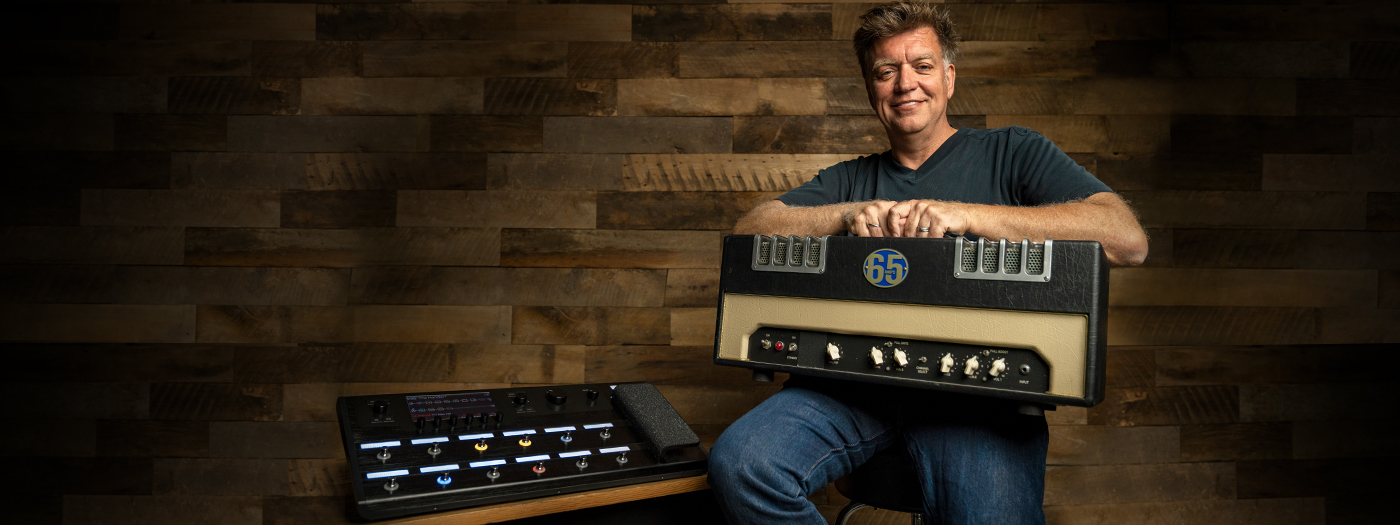Dan Boul: Crossing the Digital Divide – You Don’t Have to Choose
by Dan Boul
There’s something going on in the amp world today that genuinely surprises me. While the last few years have seen a rapid increase in the popularity of modeling amplifiers—products by Line 6, Kemper, and Fractal are currently used on roughly half of all tours, for example—the trend elicits negative, visceral responses from many guitarists. They say things like “No way, playing through a modeler is just not the same as playing through my tube amp,” “I played one years ago and didn’t get along with it, so I’m sure I’ll never like them,” and even, “I’ll never give up my favorite vintage tube amp.” These comments imply that a choice has to be made between analog tube and digital modeling amplifiers—but is that actually true?
Now, it’s important for you to know that no one is a more discerning tube amp connoisseur than I am. I adore tube amps with an almost weird level of reverence and joy, and I’ve had the bug so bad and for so long that I actually started a tube amp company. It began when I got my first Marshall in 1978—and took it all apart to figure out why it was so magical. Since then, I’ve been relentlessly looking for more and better tube amp sounds, including constantly evaluating premium vintage tubes and other components, obsessively searching for an extra two percent of improvement here and one percent there. I love tube amps!
Having said that, I’m here to tell you fellow luddites that digital modeling amps are improving almost as fast as tubes are degrading. As with all computer technologies, digital modeling technology has come very far in recent years, and the rate of improvement is accelerating. As recently as five years ago modeling amps may arguably have left a lot to be desired in terms of sound quality, playing feel, and general usability—but they are now too good to be denied. Speaking as a consultant at Line 6, living in the belly of the beast, I can tell you that both the current digital products and those still in development are genuinely impressive and quite a joy to play. Believe me when I say that the future looks very promising.
Let’s delve into this a little more deeply. In the early days of digital amp modeling not only were the tones third rate, the feel was stiff and lifeless compared to an actual tube amp. As time went on the tones got pretty believable, and sometimes even difficult to distinguish from the real thing—but the feel didn’t improve at the same pace. Until relatively recently, the liveliness, touch sensitivity, and compression characteristics just weren’t realistic enough to trigger that central part of our brains that says “happy.” So, what changed?
For starters, a digital modeling amp’s capacity to accurately reproduce tube amp detail is very reliant on computer processing power, in exactly the same way that a personal computer performs better with greater processing power and more memory. In the past few years, modeling amp developers have benefited from both a rapid increase in processing power and growing accumulated industry knowledge. Put another way, digital modeling amps are getting really fun to play!
And this is coming from a guy who manufactures hand-wired premium tube amps.
Another longtime challenge to developers of digital modeling amps is that modeling one example of, say, an AC30 is just that—a model of that particular amp. Further, the term “AC30” itself means different things to different people. Does AC30 mean The Beatles? Brian May? Mike Campbell? Any of those would be the right answer, wouldn’t they? And ditto for “Deluxe,” “Plexi,” etc. No matter how well you model an amp, it’s very difficult to model it in all states of operation, meaning some people may be disappointed because the model doesn’t meet their particular expectations as to what that amp should sound like. But, again, increased processing power and other modern technological innovations now make it possible to model amps in much greater detail, and to dial in key behaviors—as well as equally important misbehaviors—to suit your personal preferences.
Of course, even if you are technology averse and just want to play, you can usually find onboard presets that give you what you are looking for, or download presets from other users that may be more to your liking. Plus, consider the almost constant firmware updates that provide new sounds and features. There’s no downside!
You might think that I’d view all this as a threat to my existence, right? On the contrary, I see it as the natural and inevitable next evolutionary phase in amplifier development, after 60 years of tube amp dominance.
Simply put: It isn’t necessary to choose between digital modeling amps and analog tube amps. Modelers will never replace your vintage tube gear, which will remain as relevant and awesome as ever—they are just a new variation on things we all love, that offer new options. And for you creative types, they provide an excellent opportunity to expand your tone palette and explore a new technological paradigm, which alone makes the effort worthwhile. Why not embrace the new creative tools that are available to you now?
Personally, delving into modeling amps made me feel like I was truly exploring guitar sounds and behaviors again, which rejuvenated my childlike wonder and enjoyment of playing guitar. And if a cork-sniffing snob like me can find joy with these toys, chances are you can, too!

Dan Boul is a Los Angeles-based guitarist, engineer, producer, amp designer, and consultant, as well as a co-founder of the premium boutique amplifier company 65amps.
Related posts
By submitting your details you are giving Yamaha Guitar Group informed consent to send you a video series on the Line 6 Spider V MkII. We will only send you relevant information. We will never sell your information to any third parties. You can, of course, unsubscribe at any time. View our full





Leave a Reply
You must be logged in to post a comment.